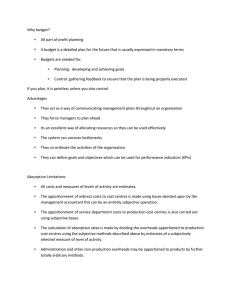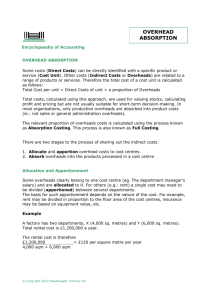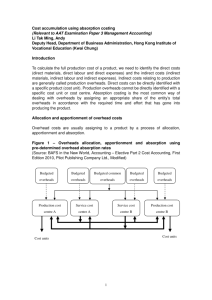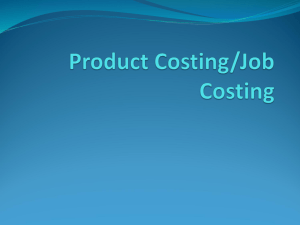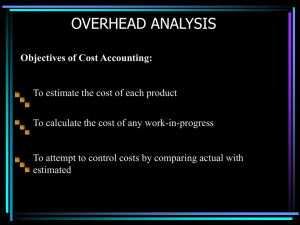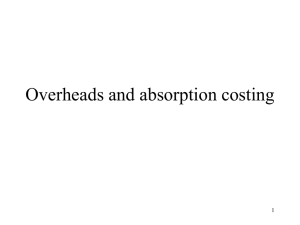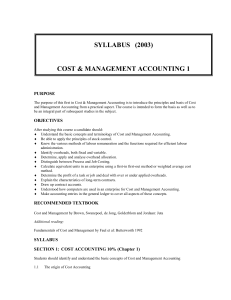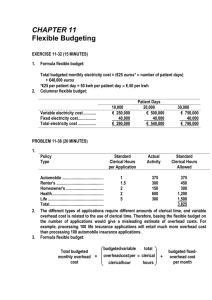Absorption (Total) Costing
advertisement
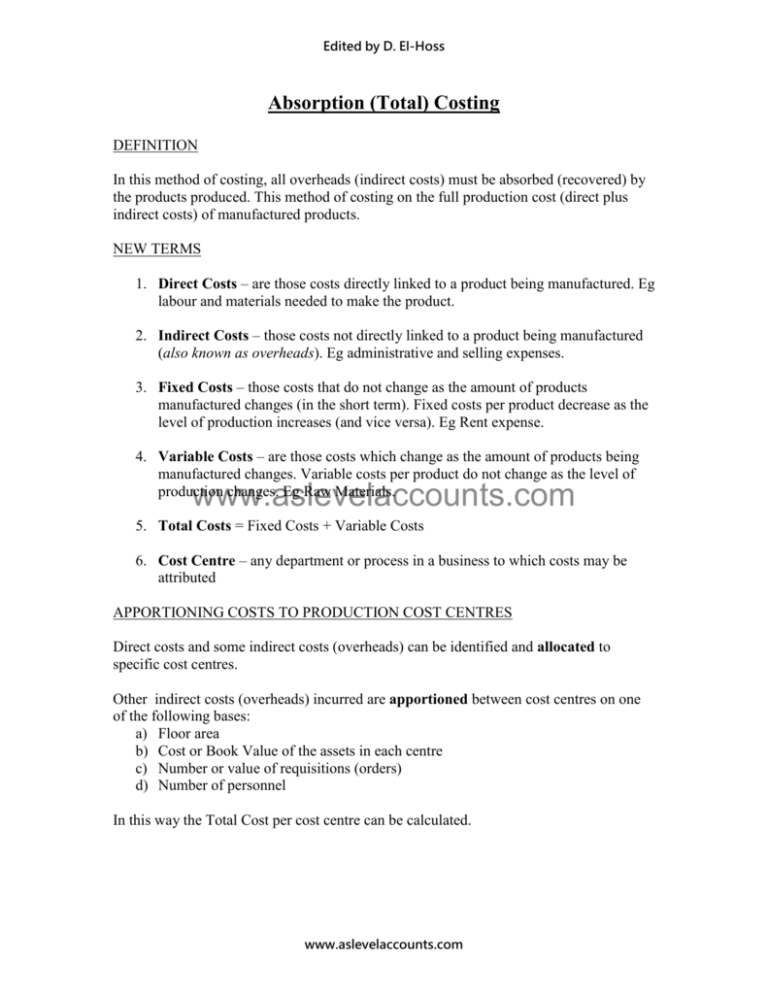
Edited by D. El-Hoss Absorption (Total) Costing DEFINITION In this method of costing, all overheads (indirect costs) must be absorbed (recovered) by the products produced. This method of costing on the full production cost (direct plus indirect costs) of manufactured products. NEW TERMS 1. Direct Costs – are those costs directly linked to a product being manufactured. Eg labour and materials needed to make the product. 2. Indirect Costs – those costs not directly linked to a product being manufactured (also known as overheads). Eg administrative and selling expenses. 3. Fixed Costs – those costs that do not change as the amount of products manufactured changes (in the short term). Fixed costs per product decrease as the level of production increases (and vice versa). Eg Rent expense. 4. Variable Costs – are those costs which change as the amount of products being manufactured changes. Variable costs per product do not change as the level of production changes. Eg Raw Materials. www.aslevelaccounts.com 5. Total Costs = Fixed Costs + Variable Costs 6. Cost Centre – any department or process in a business to which costs may be attributed APPORTIONING COSTS TO PRODUCTION COST CENTRES Direct costs and some indirect costs (overheads) can be identified and allocated to specific cost centres. Other indirect costs (overheads) incurred are apportioned between cost centres on one of the following bases: a) Floor area b) Cost or Book Value of the assets in each centre c) Number or value of requisitions (orders) d) Number of personnel In this way the Total Cost per cost centre can be calculated. www.aslevelaccounts.com Edited by D. El-Hoss APPORTIONING SERVICE COST CENTRE OVERHEADS TO PRODUCTION COST CENTRES Service cost centres provide services to the production centres. Eg Stores, Canteens Maintenance etc. The overheads of service departments must be shared / apportioned between the Production Cost Centres in order to calculate the Total Cost of goods produced.. Methods of apportioning: a) The Elimination Method The costs of the service departments are apportioned between the Production centres and other service centres. Once the costs of one service centre have been apportioned it is eliminated from the next apportionment. The basis of apportionment of the service centres could be: a) Floor area b) Cost or Book Value of the assets in each centre c) Number or value of requisitions (orders) d) Number of personnel Example: Stores must be apportioned on the basis of personnel Canteen must be apportioned on the basis of number of requisitions www.aslevelaccounts.com Cutting 20 15 Sanding 10 5 Cutting Sanding Assembly Stores 10 000 12 000 24 000 3000 6000 First Apportionment (based on 65 staff) 923 Second App (based on 30 requisitions) 3000 TOTAL COSTS 13923 462 1000 13462 1385 2000 23385 (3000) 230 (6000) - No of personnel No of Requisitions Assembly 30 10 Stores 5 2 Canteen 5 7 Apportionment: Overheads www.aslevelaccounts.com - Canteen Edited by D. El-Hoss CALCULATING OVERHEAD ABSORPTION RATES (OAR) Once overheads have been apportioned to production cost centres, the next step is to calculate the Overhead Absorption Rates. NOTE: Overhead Absorption Rates are calculated on future planned volumes of production and overhead expenditure because the cost of production must be known in advance in order to set the selling prices for the products. Methods of calculating Overhead Absorption Rates: a) On the basis of Direct Labour Hours (if production is labour intensive) Total budgeted expenditure Total budgeted labour hours x No of labour hours taken to produce one product Example: A company plans to produce 10 000 units of P and 8 000 units of Q Each unit of P requires 1 ½ hours to make and each unit of Q Takes ¾ of an hour The total budgeted overheads for the company are $131 250 Answer www.aslevelaccounts.com Total labour hours = (10 000 x 1 ½) + (8 000 x ¾) = 21 000 hours OAR for P = 131 220 21000 = $6.25 per direct labour hour The overhead absorbed by one unit of P = $6.25 x 1 ½ = $9.37 The overhead absorbed by one unit of Q = $6.25 x ¾ = $4.69 Total overhead will be absorbed as follows: P = 10 000 x $9.37 = 93 700 Q = 8 000 x $4.69 = 37 520 131220 www.aslevelaccounts.com Edited by D. El-Hoss b) On the basis of Machine Hours (if production is capital intensive) Total budgeted expenditure x Total budgeted machine hours No of machine hours taken to produce one product c) On any other basis that management decide upon Eg direct material costs; prime cost; direct wages OVER – ABSORPTION AND UNDER- ABSORPTION OF OVERHEADS Remember that Overhead Absorption Rates are calculated on future planned volumes of production and budgeted expenditure. It is most likely that the actual volume of goods produced and expenditure will be different from these forecasts. This will result in overhead expenditure being either under or over absorbed. Under-absorption – occurs actual expenditure is more than the budgeted figure and/or actual production is less than the planned level. Over-absorption – occurs when actual expenditure is less than the budgeted figure and/or actual production is more than the planned level. Example: www.aslevelaccounts.com 2005 Budgeted expenditure Planned volume of production(units) OAR = Actual expenditure Actual volume of production (units) Overhead Recovered 2006 $200 000 80 000 $240 000 100 000 200 000 = $2.50 80 000 240 000 = $2.40 100 000 $215 000 76 000 $230 000 106 000 76 000 x $2.50 = $190 000 106 000 x $2.40 = $254 400 Therefore in 2005, there was an under-absorption of: $215 000 - $190 000 = $25 000 And in 2006 there was an over-absorption of : $230 000 – 254 400 = $24 400 www.aslevelaccounts.com
